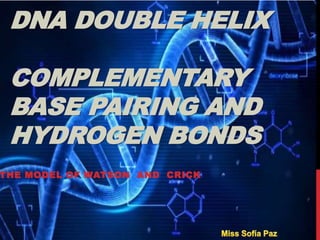
Dna double helix (2 class)
- 1. DNA DOUBLE HELIX COMPLEMENTARY BASE PAIRING AND HYDROGEN BONDS THE MODEL OF WATSON AND CRICK
- 2. NUCLEIC ACIDS (DNA AND RNA) Organic molecule Made of nucleotides (monomers) Millions of nucleotides bond to make nucleic acids (polymers, polynucleotides)
- 3. RNA Cyclic nitrogen containing molecule with properties of a base. Organic compounds.
- 4. NUCLEOTIDE
- 5. DNA Nucleic acid (polimer, polinucleotide)
- 6. DNA DNA is organized into chromosomes; when the cell is not dividing, the chromosomes appear as stringy chromatin, which is DNA wrapped around proteins (histone) A human has 46 chromosomes; around 6 feet of DNA is inside each cell nucleus (1.8 m) but is constrained in no more than 0.09 mm.
- 7. 1950’s Rosalind Franklin & Maurice Wilkins X-ray crystallography • Watson & Crick (1953 described their model) Saw the photos of R.Franklin and created a 3d model. MODEL: Sugar-phosphate backbone on the outside and bases inside of the double helix. Nitrogen bases aligned formed hydrogen bonds. Complementary base pairs, due to size of bases and ability to form hydrogen bonds with each other. They won the Nobel Prize in Physiology or Medicine 1962 "for their discoveries concerning the molecular structure of nucleic acids and its significance for information transfer in living material". DNA DOUBLE HELIX THE MODEL OF WATSON AND CRICK
- 8. COMPLEMENTARY BASE PAIRING AND HYDROGEN BONDS (DNA DOUBLE HELIX ) Base pairing: each type of nucleobase on one strand bonds with just one type of nucleobase on the other strand Hyrogen Bonds: purines form hydrogen bonds to pyrimidines. Adenine bonding only to Thymine in two hydrogen bonds Cytosine bonding only to Guanine in three hydrogen bonds Two nucleotides binding together across the double helix is called a base pair.
- 9. BASE PAIRING
- 10. DNA DOUBLE HELIX
- 11. DNA DNA is organized into chromosomes; when the cell is not dividing, the chromosomes appear as stringy chromatin, which is DNA wrapped around proteins (histone) A human has 46 chromosomes; around 6 feet of DNA is inside each cell nucleus (1.8 m).
- 12. VIDEOS What is dna http://youtu.be/1YDTOcAVJrE Dna double helix structure http://www.youtube.com/watch?v=VegLVn_1oCE
- 13. Even though it codes for all the information that makes up an organism, DNA is built using only four building blocks, the nucleotides adenine, guanine, thymine, and cytosine. Every human being shares 99% of their DNA with every other human. If you put all the DNA molecules in your body end to end, the DNA would reach from the Earth to the Sun and back over 600 times (100 trillion times six feet divided by 92 million miles). A parent and child share 99.5% of the same DNA. You have 98% of your DNA in common with a chimpanzee. AMAZING FACTS ABOUT YOUR DNA
- 14. If you could type 60 words per minute, eight hours a day, it would take approximately 50 years to type the human genome. Scientists at cambridge university believe humans have DNA in common with the mud worm and that it is the closest invertebrate genetic relative to us. In other words, you have more in common, genetically speaking, with a mud worm than you do with a spider or octopus or cockroach. Humans and cabbage share about 40-50% common DNA Friedrich miescher discovered DNA in 1869, although scientists did not understand DNA was the AMAZING FACTS ABOUT YOUR DNA
